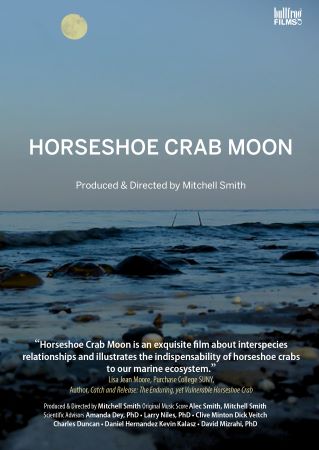
Horseshoe Crab Moon 2023
Distributed by Bullfrog Films, PO Box 149, Oley, PA 19547; 800-543-FROG (3764)
Produced by MediaSmith Films
Directed by Mitchell Smith
Streaming, 48 mins
College - General Adult
Biology; Ecology
Date Entered: 06/02/2023
Reviewed by Abbey B. Lewis, STEM Engagement Librarian, University of Colorado BoulderAs a keystone species, horseshoe crabs have a major role in the food web of the Delaware Bay. Once abundant throughout the region, their numbers have markedly declined in recent years due to human activity. Their eggs are a significant food source for multiple species, some of which are under threat themselves. Horseshoe Crab Moon focuses on a team of scientists and volunteers led by biologists Amanda Dey and Lawrence Niles, studying the effects of the declining crab population on the Red Knot, a shorebird that relies on the eggs to build enough body mass to reach breeding grounds in the Arctic.
Through thoughtful interviews with the research team, as well as clips showing their fieldwork, the film does an outstanding job of conveying how scientists can use research to address complex ecological problems. Viewers get a close up look at the tools and strategies that enable data collection. Although the solution seems simple - more horseshoe crab eggs will increase the Red Knot’s survival rates, as well as those of other species - understanding the interrelated factors that could make it possible requires forming appropriate research questions and determining reliable tactics for answering them. How many horseshoe crab eggs are laid on the shore each year? How many Red Knots return to the Delaware Bay and where else do they travel? It’s fascinating to watch the team sift through sand or catch Red Knots in a huge net to tag them with geolocator bands.
Aside from the scientific aspects, Horseshoe Crab Moon gives significant insight into how researchers need to consider government and public support for addressing ecological problems. In 1997, researchers were aware of the threat posed to shorebirds by the declining horseshoe crab population. Instead of imposing appropriate regulations, the government favored the interests of fishermen using the crabs as bait. Although their predictions were accurate, there’s still pushback from groups who believe that harvesting bans are unnecessary. Backed up by their meticulously collected evidence, Dey and Niles know what actions would lead to successfully restored populations. In the end, the problem isn’t finding a way to increase the number of eggs. It’s finding a way to bridge the disconnect between science and policy.
Horseshoe Crab Moon is highly recommended for academic libraries because of the multiple ways that it could readily connect with a course’s learning goals. It’s an excellent example of interactions between species and human impacts on ecosystems. It demonstrates how research design and data collection work in field ecology and can be used to show changes in an ecosystem over time. It also effectively shows the impacts of research (or perils of inaction) on real-world problems. This would be a perfect film for classes that introduce students to field ecology and instructors in biology and environmental studies are likely to find it useful for many other course objectives as well.
Published and licensed under the Creative Commons Attribution 4.0 license. Anyone can use these reviews, so long as they comply with the terms of the license.